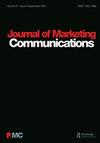象形图排列如何影响消费者的乐观和判断
Q1 Business, Management and Accounting
引用次数: 0
摘要
摘要频率象形图是通信中定量信息最常用的图形表示形式之一。本文表明,当用排序象形图表示与用未排序象形图表示时,个体对客观等价信息的反应不同。我们发现,当看到排序象形图中的数字信息时,个体会比看到未排序象形图时形成更乐观的判断。在六项研究的属性框架背景下,我们证明了上述现象,并找到了乐观偏见的潜在机制的证据。本文论证了不同语境下传达频率信息的象形文字的感知特征对消费者自我相关判断的影响。此外,本文通过使用数字信息的图形表示来展示属性框架的效果,从而为属性框架领域做出了贡献。关键字:象形文字属性框架乐观主义偏置框架图形属性框架披露声明所有作者证明他们与任何组织或实体没有任何关联或参与,在本文中讨论的主题或材料中有任何经济或非经济利益。我们预先测试了“就业”场景,参与者直接获得就业/失业信息,而不使用象形图。基本上,积极(消极)框架的参与者被告知“假设你在黑山国家找工作。”黑山的就业率(失业率)为80%(20%)。“在这种情况下,框架效应非常显著,因为积极框架(80%的就业率)的参与者对找到工作的机会的判断明显高于消极框架(20%的失业率)的参与者。”然而,平均回答并不能给出完整的画面,因为回答的差异(未排序条件下为6.66,而排序条件下为4.7)向我们表明,显示排序象形图的个体的回答比显示未排序象形图的个体的回答更接近正确答案。尽管存在巨大的差异,但平均响应更接近平均值,这很好地证明了高尔顿稳健的“群体智慧”数学现象。(高尔顿,Citation1907;Citation2004 Surowiecki)。没有收到用于准备这篇手稿的资金。作者简介gaurav Jain,伦斯勒理工学院Lally管理学院市场营销学助理教授(邮箱:gauraj@rpi.edu)。主要研究方向为数字认知、判断和记忆。他还在研究中使用心理-物理方法。本文作者是曼哈顿学院奥马利管理学院市场营销学助理教授(邮箱:sshrivastava01@manhattan.edu)。她曾在一家领先的市场营销公司Ipsos担任高级行为科学家。Zeynep Ece Tolun是伦斯勒理工学院Lally管理学院的博士生(电子邮件:tolunz@rpi.edu)。她拥有土耳其比尔肯特大学的学士学位。主要研究方向为行为金融学、财务决策和认知偏差。本文章由计算机程序翻译,如有差异,请以英文原文为准。
How pictogram arrangements impact consumer optimism and judgments
ABSTRACTFrequency pictograms are one of the most common graphical representations of quantitative information used in communication. The paper shows that individuals react differently to objectively equivalent information when represented in a sorted pictogram versus an unsorted pictogram. We show that individuals form more optimistic judgments when presented with numerical information in a sorted pictogram than in an unsorted pictogram. Using the backdrop of attribute framing across six studies, we demonstrate the aforementioned phenomenon and find evidence of an optimism bias-based underlying mechanism. This paper demonstrates the impact of the perceptual features of pictograms that communicate frequency information in different contexts on consumers’ self-related judgments. Additionally, the paper contributes to the field of attribute framing by demonstrating its effects using a graphical representation of numerical information.KEYWORDS: Pictogramsattribute framingoptimism biasgraphical framinggraphical attribute framing Disclosure statementAll authors certify that they have no affiliations with or involvement in any organization or entity with any financial or non-financial interests in the subject matter or materials discussed in this manuscript.Notes1. We had pre-tested the ‘employment’ scenario where participants were given the employment/unemployment information directly without using the pictograms. Essentially, participants in the positive (negative) frame were told ‘Suppose you are looking for a job in the country of Montenegro. The employment rate (unemployment rate) in Montenegro is 80% (20%).’ The framing effects were significant for this scenario as participants in the positive (80% employment) frame had a significantly higher judgment of the chances of getting a job than the participants in the negative (20% unemployment) frame.2. However, average response does not give the complete picture, as the variance in responses (6.66 in the unsorted condition versus 4.7 in the sorted condition) shows us that the responses by individuals who were shown the sorted pictogram were much closer to the correct answer than those who were shown the unsorted pictogram. The average response being closer to the mean despite the huge variance is a good demonstration of the Galton’s robust mathematical phenomenon of ‘wisdom of the crowd’. (Galton, Citation1907; Surowiecki, Citation2004).Additional informationFundingNo funding was received for preparation of this manuscript.Notes on contributorsGaurav JainGaurav Jain is an Assistant Professor of Marketing at Lally School of Management, Rensselaer Polytechnic Institute (email: gauraj@rpi.edu). His research interests are numerical cognition, judgment and memory. He also uses psycho-physical methods in his research.Sunaina ShrivastavaSunaina Shrivastava is an Assistant Professor of Marketing at O’Malley School of Management, Manhattan College (email: sshrivastava01@manhattan.edu). Shehas previously served as a senior behavioral scientist in a leading marketing firm Ipsos.Zeynep Ece TolunZeynep Ece Tolun is a Ph.D. Student at Lally School of Management, Rensselaer Polytechnic Institute (email: tolunz@rpi.edu). She holds a bachelor’s degree from Bilkent University, Turkey. Her research interests are behavioral finance, financial decision-making, and cognitive biases.
求助全文
通过发布文献求助,成功后即可免费获取论文全文。
去求助
来源期刊

Journal of Marketing Communications
Business, Management and Accounting-Business and International Management
CiteScore
7.70
自引率
0.00%
发文量
44
期刊介绍:
The Journal of Marketing Communications is a double-blind peer-reviewed journal devoted to publishing research papers and information concerning all aspects of marketing and corporate communication, branding both corporate and product-related, and promotion management. It is a channel for discussing issues such customer relationship management, integrated marketing communication, together with behavioural foundations of marketing communications and promotion management. The Journal will also consider papers in internal marketing and in the corporate communications domain.
 求助内容:
求助内容: 应助结果提醒方式:
应助结果提醒方式:


